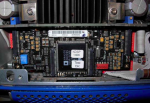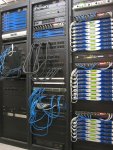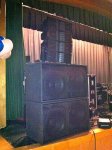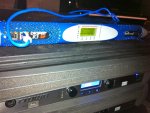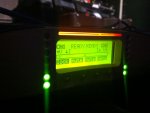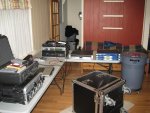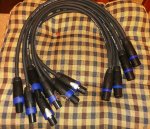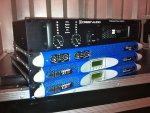 It has been an amazing number of years, from my perspective, since I last took some Powersoft amps out and rode them hard. I was very impressed with them then, and since that time they have only gotten more interesting.
It has been an amazing number of years, from my perspective, since I last took some Powersoft amps out and rode them hard. I was very impressed with them then, and since that time they have only gotten more interesting.As a general rule, I find amplifiers unexciting. I need a certain number of volts delivered into a certain load, I take whatever pro level amp will do it. I like big peak power, but I like to limit long term power so drivers don't really see power compression (which works better with some drivers in some boxes than others). I haven't spent a lot of time sweating about it since I am always more concerned about variation between loudspeakers, and nowadays I'm usually getting whatever the provider has set up for their rig anyway... which tends to be pretty big power regardless.
A few months ago I was put in contact with Ken Blecher, Vice President and Director of Business Development for the U.S. operation of Powersoft Advanced Technologies, LLC. I mentioned that I would love to take the new K20, which claims to deliver 18,000 watts into 2 ohms, for a spin. That is an amazing power figure, but I was also interested in trying out their new-to-me DSP integration which I had seen a little at trade shows but not really kicked around. Ken told me he'd be happy to send me a pair of K20s (5,200wpc into 4Ω), but I should also take a look at the new K3 (2,600wpc into 4Ω) and their four channel M50Q (1,250wpc into 4Ω), also available with DSP. Long story short, a few weeks later I was driving around with more than 45,000 watts in the trunk of my car.
Now, not only do the K and M series amps have top of the line power points, they are part of this latest crop with very tight DSP integration. I have always said (I swear!) that by integrating DSP with an amplifier it should be possible to reduce setup errors and squeeze even more performance out of loudspeakers, since limiter thresholds will no longer be dependent on amp gain and a smart amp could even tell how much power it was actually delivering. Other manufacturers have made large strides in this regard, but the Powersoft is the most impressive I've seen yet. I'll get to that in a moment.
Physical Size and Weight
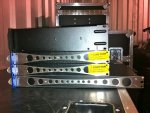 When I heard of the new K3 I assumed it was the same chassis I was used to, at a power point less than the K4 I had already seen. As you may have suspected by now, it's a totally new chassis that answers a lot of complaints from people who have trouble fitting the Powersoft amps in their racks due to their unusual depth (nearly 19" for the K20). The K3 (and K2) is just over 14" deep, which as you can see is well in line with other amplifiers you may be used to. It also weighs less, a little under 18lbs compared to the K20's nearly 27lbs... not that I'm complaining! These are all lightweight amps, the K3 just hits a very welcome power point in a really exceptional size and weight. That power point, only half that of the K20 (although the K3 will not drive 2 ohm loads as readily) at 2,600wpc into 4 ohms stereo or 5,600w into 4 ohms bridged, is more than many top of the line 2U workhorse amplifiers and outstanding for many pro audio tasks. The K3 is the most interesting of the bunch to me for this and several other reasons.
When I heard of the new K3 I assumed it was the same chassis I was used to, at a power point less than the K4 I had already seen. As you may have suspected by now, it's a totally new chassis that answers a lot of complaints from people who have trouble fitting the Powersoft amps in their racks due to their unusual depth (nearly 19" for the K20). The K3 (and K2) is just over 14" deep, which as you can see is well in line with other amplifiers you may be used to. It also weighs less, a little under 18lbs compared to the K20's nearly 27lbs... not that I'm complaining! These are all lightweight amps, the K3 just hits a very welcome power point in a really exceptional size and weight. That power point, only half that of the K20 (although the K3 will not drive 2 ohm loads as readily) at 2,600wpc into 4 ohms stereo or 5,600w into 4 ohms bridged, is more than many top of the line 2U workhorse amplifiers and outstanding for many pro audio tasks. The K3 is the most interesting of the bunch to me for this and several other reasons.The M50Q, while the same physical size as the K3, is even lighter at 16lbs. I am surprised it is only 2lbs lighter, since it feels much lighter than the K3. All these amps seem heavier than expected because they are so small, when you heft a 2U amp and it's 30lbs you were kind of expecting it. When a 1U amp is more than 16lbs it's a brick, you can't win. Nevertheless, a rack of these will be an easy lift. The power point for the M50Q works out to about 1,250 watts per channel into 4 ohms, which should be great on horns or mids. Here's a way to get your monitor rig really power dense. With no visible controls other than gain it's not even obvious there's DSP inside, which could be a real boon for installers.
The K20, shown at the bottom of the pile in the stack above, is the same physical size as the familiar K4, K6, K8, and K10. Except for the label on the front they are indistinguishable. It is even the same weight, which leads me to believe the main difference is the availability of several years development in output device voltage and current ratings. After all, the K20 will deliver 225v into a load, which is simply enormous. Almost unusable. I don't want to say something that will be laughably proven wrong in a decade, but it is difficult to imagine a professional loudspeaker driver that can take the kind of power the K20 is capable of delivering. Unfortunately, the K20 cannot be up/downgraded like the K4-10 through software, so you're making a commitment to winning any amp power competitions when you buy it.
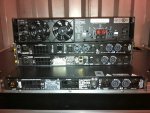 Amplifier technology is surely advancing at a pace that greatly outstrips driver development, and from a box and system tuner's perspective being able to deliver big peak power is a huge boon in terms of performance and sonic quality. If you figure that live music has at least 10dB dynamic range (and more like 12-18dB), a driver that can take 400w of long term power is being constrained from maximum performance by an amp delivering any less than 4,000w. So while almost any modern amp can burn up almost any modern driver, it takes an amp the size of the K20 to be able to deliver the full waveform without clipping... and I wouldn't mind even a little more
Amplifier technology is surely advancing at a pace that greatly outstrips driver development, and from a box and system tuner's perspective being able to deliver big peak power is a huge boon in terms of performance and sonic quality. If you figure that live music has at least 10dB dynamic range (and more like 12-18dB), a driver that can take 400w of long term power is being constrained from maximum performance by an amp delivering any less than 4,000w. So while almost any modern amp can burn up almost any modern driver, it takes an amp the size of the K20 to be able to deliver the full waveform without clipping... and I wouldn't mind even a little more Pricing
I will say right up front that I do not buy gear, so I have no idea what these cost. Since they represent the absolute bleeding edge in power density and performance I would expect them to cost a premium. Whether that is worth it to you is a decision you have to make for yourself, but I can count on one hand the number of amps that can approach these in any metric... and I do mean approach. Not only is there room for performance and sonic gains by using amps like these, loudspeaker limits can be approached even more safely through the use of their excellent DSP integration, networking, and monitoring. As you will see later in my review these amplifiers can form the backbone of a system that is a joy to work with from a technical perspective, and also a joy to work with from a sonic perspective. I am really, really impressed.


